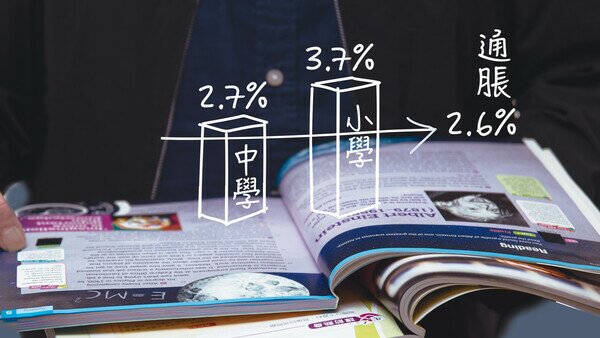Expenditure on textbooks is a heavy burden for parents whenever their children commence a new school year. According to the Consumer Council’s 2019/20 annual textbook expenditure survey for primary and secondary schools, the average textbook expenditure for primary and secondary school students had surged with the prices of primary school textbooks rose by 3.7% on average when compared with those of last year, while secondary school textbook prices increased by 2.7%. The increases were higher than the 2.6% inflation rate over the same period. The surge in Primary 6 and Form 5 textbook prices was the most significant with increases of 4.2% and 4.6% respectively. Moreover, there were huge differences in textbook expenditure among schools, in particular for senior forms of secondary schools with the disparity of more than 4 times.
The survey was conducted by random sampling. The Council sent letters to 87 primary schools and 77 secondary schools to enquire about booklist information, including the net price after discount for compulsory textbooks, exercise books, and school-based learning materials. As at the end of August, 54 primary schools and 47 secondary schools had provided the information, giving a 61.6% response rate which was the highest in 3 years for the Council’s annual textbook expenditure survey.
Among the primary school grades, the average textbook expenditure for Primary 1 was the lowest at $2,660 while that of Primary 5 was the highest at $2,971. The average increase for each grade was from 3.3% to 4.2%. For secondary schools, the average increase varied from 0.3% to 4.6%. The average textbook expenditure for Form 4 was the highest at $3,355 while that of Form 6 was the lowest at only $895. The main reason for the difference was because most students had bought the senior-form books when they were in Form 4.
The survey also compared inter-school differences in textbook expenditure for the same forms. For instance, the highest textbook expenditure for Form 4 was $6,143 and the lowest was $1,218, a difference of 4 times. This may be due to the difference in the number of textbooks, the volume of exercises for the core subjects, and the number of enrolled elective subjects available for students. For Primary 1, the highest textbook expenditure was $3,443, which was 2 times more than the lowest amount of $1,050. The main reason for the difference was the variation in the number of supplementary exercise books required by various schools. This was also related to the provision of free English teaching materials produced by individual schools.
The survey also found that bookstores which helped schools compile the textbook lists normally offered discounts to primary and secondary schools. 42 primary schools (78%) enjoyed discounts ranging from 11% to 15%. Secondary schools generally had lower discounts than primary schools with 35 secondary schools having a discount of only 5 to 10%, while 9 schools received a higher discount of 11 to 12%. The findings of this year’s survey in relation to discount were similar to those of last year.
The trend of using information technology in teaching is generally on the rise. The survey discovered that about 50% of the responding primary schools had adopted e-textbooks, showing a significant increase when compared with that last year (38%). Of these, 11 schools replied that they used e-textbooks as supplementary materials with most of them providing additional facilities to facilitate students’ use while a small number of these schools even purchased tablets on behalf of the students, ranging from $3,000 to $5,000 each. As for secondary schools, the utilisation rate of e-textbooks was remarkably lower than that of primary schools with slightly more than 5% of the secondary schools using e-textbooks.
The survey also revealed that e-textbooks were generally ordered directly by the schools with no discount offered. Therefore, in 1 of the surveyed schools using e-textbooks, the expenditure for the entire textbook lists of the classes was approximately 3% higher than those of classes using printed books. Purchasing second-hand books is environmentally friendly and money saving. The survey showed that reminders on the use of second-hand books were printed on approximately 60% of primary school and 85% of secondary school textbook lists. For example, some booklists contain reminders, such as “Reprinted with minor amendments” and “Not a new edition”, implying that students can use second-hand books as long as they get the related appendices or corrigenda to update them. This is a praiseworthy practice for all schools to follow.
The Consumer Council reserves all its right (including copyright) in respect of CHOICE magazine and Online CHOICE.



